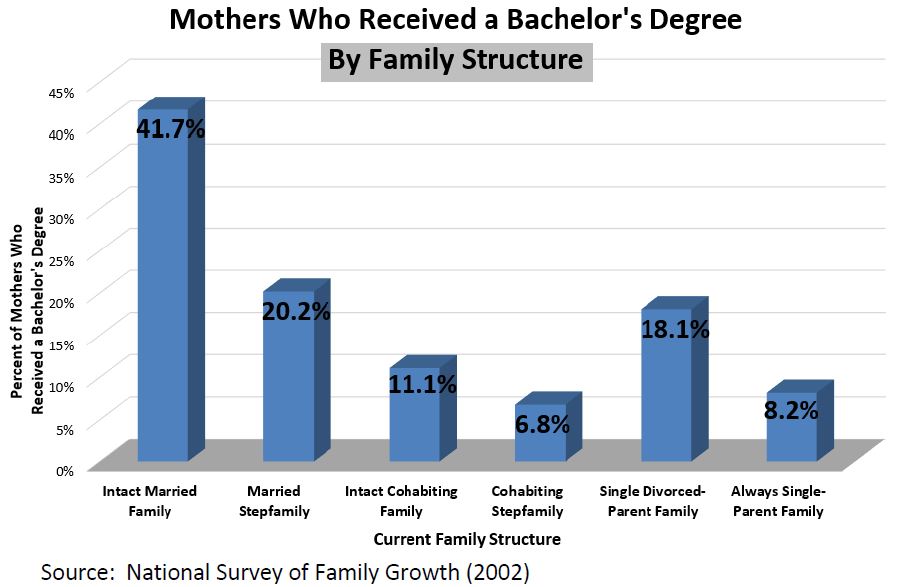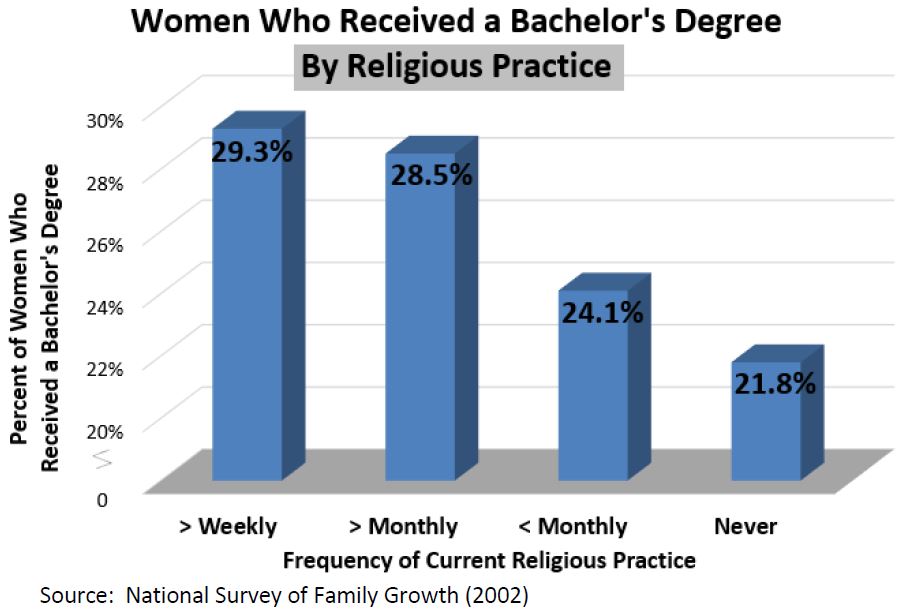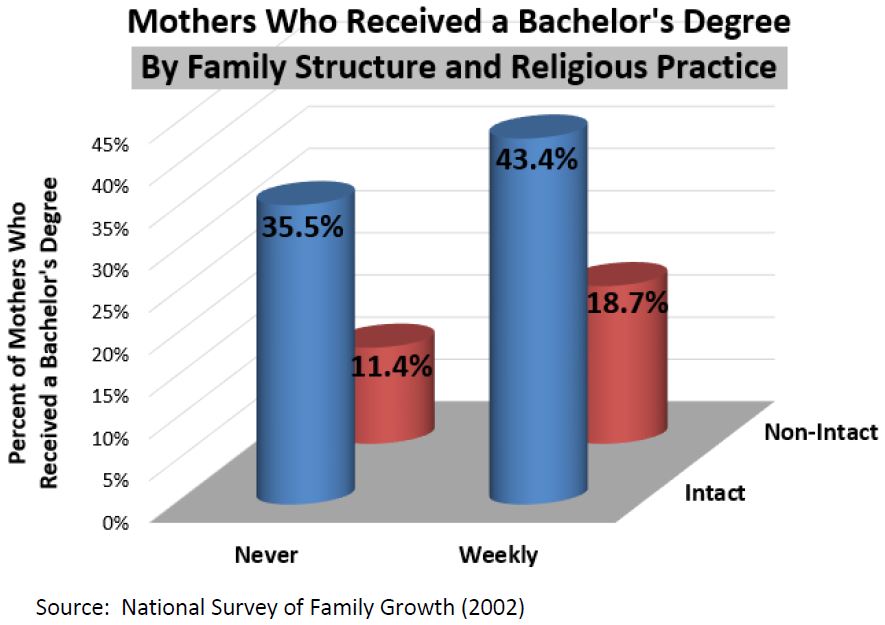Click Here to download “Women Who Received a Bachelor’s Degree by Family Structure and Religious Practice”
Women Who Received a Bachelor’s Degree by Family Structure and Religious Practice
Family Structure: According to the 2002 National Survey of Family Growth, 41.7 percent of mothers aged 35-44 in always-intact marriages had earned a bachelor’s degree, followed by mothers in married stepfamilies (20.2 percent), those who were divorced (18.1 percent), those in intact cohabiting relationships (11.1 percent), those who had always been single (8.2 percent), and those in cohabiting stepfamilies (6.8 percent).
[1]
 Religious Practice:
Religious Practice: Based on the National Survey of Family Growth, Cycle 6, 29.3 percent of women
[2] aged 35-44 who worshipped at least weekly attained a bachelor’s degree, followed by those who attended religious services between one and three times a month (28.5 percent), those who attended religious services less than once a month (24.1 percent), and those who never attended religious services (21.8 percent).
 Family Structure and Religious Practice Combined:
Family Structure and Religious Practice Combined: Mothers aged 35-44 in always-intact marriages who worshipped at least weekly were more likely to have earned a bachelor’s degree than mothers in all other family structure and worship combinations. According to the National Survey of Family Growth, 43.4 percent of mothers in always-intact marriages who attended religious services at least weekly attained a bachelor’s degree, followed by mothers in always-intact marriages who never worshipped (35.5 percent), those in other family structures who worshipped at least weekly (18.7 percent), and those in other family structures who never worshipped (11.4 percent).
 Related Insights from Other Studies:
Related Insights from Other Studies: Several other studies corroborate the direction of these findings. Jonathan Gruber of the Massachusetts Institute of Technology reported that those who live in a community with high levels of church attendance not only tend to attend church frequently themselves but also attain higher levels of education.
[3]
Kelly Raley of the University of Texas at Austin and Larry Bumpass of the University of Wisconsin also found that “60 percent of the marriages of high school dropouts end in divorce compared to 36 percent among college graduates.”
[4]
Christine R. Schwartz and Robert D. Mare of the University of California, Los Angeles reported that the likelihood that those with college degrees would marry those without any college education has declined since the 1940s.
[5
As the data show, women in always-intact marriages who worship at least weekly are the most likely to have received a bachelor’s degree.
[1] These charts draw on data collected by the National Survey of Family Growth, Cycle 6 (2002). The sample consists of women between the ages of 35 and 44 and numbers 2,479.
[2] Whereas the present family structure data and combined religious attendance/family structure data include mothers only, the religious attendance data include
all women between the ages of 35 and 44 in the sample. We realize these charts would have more value if all three charts drew from the same population set, but the difference was only noted after the data was in.
[3] Jonathan Gruber, “Religious Market Structure, Religious Participation, and Outcomes: Is Religion Good for You?” National Bureau of Economic Research, Working Paper 11377 (2005).
[4] R. Kelly Raley and Larry Bumpass, “The Topography of the Divorce Plateau: Levels and Trends in Union Stability in the United States after 1980,”
Demographic Research 8 (2003): 245-60.
[5] Christine R. Schwartz and Robert D. Mare, “Trends in Educational Assortative Marriage from 1940 to 2003,”
Demography 42 (2005): 621-46.]]>
 Religious Practice: Based on the National Survey of Family Growth, Cycle 6, 29.3 percent of women[2] aged 35-44 who worshipped at least weekly attained a bachelor’s degree, followed by those who attended religious services between one and three times a month (28.5 percent), those who attended religious services less than once a month (24.1 percent), and those who never attended religious services (21.8 percent).
Religious Practice: Based on the National Survey of Family Growth, Cycle 6, 29.3 percent of women[2] aged 35-44 who worshipped at least weekly attained a bachelor’s degree, followed by those who attended religious services between one and three times a month (28.5 percent), those who attended religious services less than once a month (24.1 percent), and those who never attended religious services (21.8 percent).
 Family Structure and Religious Practice Combined: Mothers aged 35-44 in always-intact marriages who worshipped at least weekly were more likely to have earned a bachelor’s degree than mothers in all other family structure and worship combinations. According to the National Survey of Family Growth, 43.4 percent of mothers in always-intact marriages who attended religious services at least weekly attained a bachelor’s degree, followed by mothers in always-intact marriages who never worshipped (35.5 percent), those in other family structures who worshipped at least weekly (18.7 percent), and those in other family structures who never worshipped (11.4 percent).
Family Structure and Religious Practice Combined: Mothers aged 35-44 in always-intact marriages who worshipped at least weekly were more likely to have earned a bachelor’s degree than mothers in all other family structure and worship combinations. According to the National Survey of Family Growth, 43.4 percent of mothers in always-intact marriages who attended religious services at least weekly attained a bachelor’s degree, followed by mothers in always-intact marriages who never worshipped (35.5 percent), those in other family structures who worshipped at least weekly (18.7 percent), and those in other family structures who never worshipped (11.4 percent).
 Related Insights from Other Studies: Several other studies corroborate the direction of these findings. Jonathan Gruber of the Massachusetts Institute of Technology reported that those who live in a community with high levels of church attendance not only tend to attend church frequently themselves but also attain higher levels of education.[3]
Kelly Raley of the University of Texas at Austin and Larry Bumpass of the University of Wisconsin also found that “60 percent of the marriages of high school dropouts end in divorce compared to 36 percent among college graduates.”[4]
Christine R. Schwartz and Robert D. Mare of the University of California, Los Angeles reported that the likelihood that those with college degrees would marry those without any college education has declined since the 1940s.[5
As the data show, women in always-intact marriages who worship at least weekly are the most likely to have received a bachelor’s degree.
[1] These charts draw on data collected by the National Survey of Family Growth, Cycle 6 (2002). The sample consists of women between the ages of 35 and 44 and numbers 2,479.
[2] Whereas the present family structure data and combined religious attendance/family structure data include mothers only, the religious attendance data include all women between the ages of 35 and 44 in the sample. We realize these charts would have more value if all three charts drew from the same population set, but the difference was only noted after the data was in.
[3] Jonathan Gruber, “Religious Market Structure, Religious Participation, and Outcomes: Is Religion Good for You?” National Bureau of Economic Research, Working Paper 11377 (2005).
[4] R. Kelly Raley and Larry Bumpass, “The Topography of the Divorce Plateau: Levels and Trends in Union Stability in the United States after 1980,” Demographic Research 8 (2003): 245-60.
[5] Christine R. Schwartz and Robert D. Mare, “Trends in Educational Assortative Marriage from 1940 to 2003,” Demography 42 (2005): 621-46.]]>
Related Insights from Other Studies: Several other studies corroborate the direction of these findings. Jonathan Gruber of the Massachusetts Institute of Technology reported that those who live in a community with high levels of church attendance not only tend to attend church frequently themselves but also attain higher levels of education.[3]
Kelly Raley of the University of Texas at Austin and Larry Bumpass of the University of Wisconsin also found that “60 percent of the marriages of high school dropouts end in divorce compared to 36 percent among college graduates.”[4]
Christine R. Schwartz and Robert D. Mare of the University of California, Los Angeles reported that the likelihood that those with college degrees would marry those without any college education has declined since the 1940s.[5
As the data show, women in always-intact marriages who worship at least weekly are the most likely to have received a bachelor’s degree.
[1] These charts draw on data collected by the National Survey of Family Growth, Cycle 6 (2002). The sample consists of women between the ages of 35 and 44 and numbers 2,479.
[2] Whereas the present family structure data and combined religious attendance/family structure data include mothers only, the religious attendance data include all women between the ages of 35 and 44 in the sample. We realize these charts would have more value if all three charts drew from the same population set, but the difference was only noted after the data was in.
[3] Jonathan Gruber, “Religious Market Structure, Religious Participation, and Outcomes: Is Religion Good for You?” National Bureau of Economic Research, Working Paper 11377 (2005).
[4] R. Kelly Raley and Larry Bumpass, “The Topography of the Divorce Plateau: Levels and Trends in Union Stability in the United States after 1980,” Demographic Research 8 (2003): 245-60.
[5] Christine R. Schwartz and Robert D. Mare, “Trends in Educational Assortative Marriage from 1940 to 2003,” Demography 42 (2005): 621-46.]]>
